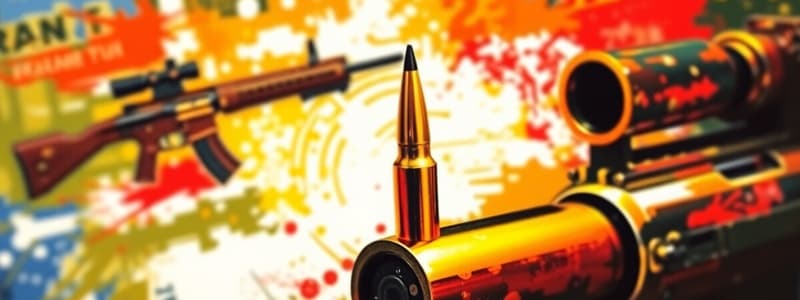Podcast
Questions and Answers
What adjustment is made to the gun ports in extreme cold weather?
What adjustment is made to the gun ports in extreme cold weather?
- Set at 4 mm (correct)
- Set at 3 mm
- Set at 5 mm
- Set at 6 mm
What is the primary function of the Bolt Assembly?
What is the primary function of the Bolt Assembly?
- Aiming at targets
- Transporting cartridges
- Loading and locking (correct)
- Firing and ejecting
What is the main role of the Feed Mechanism?
What is the main role of the Feed Mechanism?
- To aim at targets
- To eject spent cartridges
- To fire the machine gun
- To move cartridges to the feeding position (correct)
What is the fixed traverse elevation (TE) of the weapon?
What is the fixed traverse elevation (TE) of the weapon?
What is the purpose of the Sighting Mechanism?
What is the purpose of the Sighting Mechanism?
What components are included in the AA Sighting Equipment?
What components are included in the AA Sighting Equipment?
At what distance should an object be aligned with the AA sight for proper targeting?
At what distance should an object be aligned with the AA sight for proper targeting?
Which mechanism is responsible for placing the first cartridge to be fired?
Which mechanism is responsible for placing the first cartridge to be fired?
Where should the short feed arm be placed during assembly?
Where should the short feed arm be placed during assembly?
What should be done after tightening the nut and inserting the split pin?
What should be done after tightening the nut and inserting the split pin?
How should the trigger mechanism frame be replaced?
How should the trigger mechanism frame be replaced?
What is the purpose of the sear spring in normal conditions?
What is the purpose of the sear spring in normal conditions?
What must be done with the rear sight leaf after replacing the back plate group?
What must be done with the rear sight leaf after replacing the back plate group?
During the loading process, what ensures the first round is held in place?
During the loading process, what ensures the first round is held in place?
What effect does pulling the loading handle have on the bolt slide?
What effect does pulling the loading handle have on the bolt slide?
What is the function of the trunnion locking bolts after assembling the gun?
What is the function of the trunnion locking bolts after assembling the gun?
What is the first step in removing the gas regulator?
What is the first step in removing the gas regulator?
How should the gas regulator be aligned when replacing it?
How should the gas regulator be aligned when replacing it?
What should be done immediately after engaging the wrench on the piston lever?
What should be done immediately after engaging the wrench on the piston lever?
What sequence should be followed for the assembly of the components?
What sequence should be followed for the assembly of the components?
How should the firing pin head be positioned when replacing it?
How should the firing pin head be positioned when replacing it?
What is the function of the split pin after replacing the gas regulator?
What is the function of the split pin after replacing the gas regulator?
What is the first component that is removed when disassembling the barrel?
What is the first component that is removed when disassembling the barrel?
What is one primary reason for disassembling the machine gun?
What is one primary reason for disassembling the machine gun?
What must be aligned when replacing the barrel?
What must be aligned when replacing the barrel?
What should be the first step when removing the back plate group?
What should be the first step when removing the back plate group?
Which component must be removed after pulling out the split pin?
Which component must be removed after pulling out the split pin?
How should the rear part of the receiver be handled while removing the bolt assembly?
How should the rear part of the receiver be handled while removing the bolt assembly?
What is essential to do after separating the bolt body from the bolt slide?
What is essential to do after separating the bolt body from the bolt slide?
What direction should the feed mechanism cover be turned to remove the coned axle of the short feed arm?
What direction should the feed mechanism cover be turned to remove the coned axle of the short feed arm?
When removing the trigger mechanism frame, which part should be held to ensure safe removal?
When removing the trigger mechanism frame, which part should be held to ensure safe removal?
What tool should be used to unscrew the trunnion locking nuts during the disassembly process?
What tool should be used to unscrew the trunnion locking nuts during the disassembly process?
What must be considered when determining the type of air threat?
What must be considered when determining the type of air threat?
What is essential for ensuring good site selection for an AAMG?
What is essential for ensuring good site selection for an AAMG?
Which factor is NOT considered important when planning air defense design?
Which factor is NOT considered important when planning air defense design?
What must a defender do to ensure an effective deployment pattern?
What must a defender do to ensure an effective deployment pattern?
Why is good camouflage important for an AAMG site?
Why is good camouflage important for an AAMG site?
What is the maximum allowable horizontal movement correction indicated by the front sight of a 12.7 AAMG?
What is the maximum allowable horizontal movement correction indicated by the front sight of a 12.7 AAMG?
How does vertical allowable correction differ from horizontal allowable correction?
How does vertical allowable correction differ from horizontal allowable correction?
What might limit the number of weapons available for a particular formation or unit?
What might limit the number of weapons available for a particular formation or unit?
What happens when the camming shoulders of the firing pin are out of the locks?
What happens when the camming shoulders of the firing pin are out of the locks?
What is the role of the return spring during the bolt slide's rearward movement?
What is the role of the return spring during the bolt slide's rearward movement?
What occurs when the trigger plate is pulled?
What occurs when the trigger plate is pulled?
Which component directly feeds the first round into the chamber?
Which component directly feeds the first round into the chamber?
What function does the limiting mechanism serve in relation to the long feed arm?
What function does the limiting mechanism serve in relation to the long feed arm?
How is the bolt body maneuvered during the operation of the bolt slide?
How is the bolt body maneuvered during the operation of the bolt slide?
What action occurs just after the bolt slide moves rearward and the sear groove is locked?
What action occurs just after the bolt slide moves rearward and the sear groove is locked?
In the process of firing, what does the cocking handle do during forward movement?
In the process of firing, what does the cocking handle do during forward movement?
Flashcards
What does the receiver do?
What does the receiver do?
The receiver is the central part of the machine gun. It holds the barrel assembly, bolt assembly, and trigger mechanism, allowing for the smooth operation of the gun and ensuring it locks properly.
What is the main function of the bolt assembly?
What is the main function of the bolt assembly?
The bolt assembly is responsible for the entire firing cycle. It includes loading, locking, firing, extracting, and ejecting the cartridge.
What does the feed mechanism do?
What does the feed mechanism do?
The feed mechanism ensures continuous firing by moving cartridges to the feeding position for automatic firing.
What does the trigger mechanism do?
What does the trigger mechanism do?
Signup and view all the flashcards
What is the purpose of the gun mount?
What is the purpose of the gun mount?
Signup and view all the flashcards
What is the role of the locking mechanism?
What is the role of the locking mechanism?
Signup and view all the flashcards
What is the primary function of the fine sighting mechanism?
What is the primary function of the fine sighting mechanism?
Signup and view all the flashcards
How does the loading mechanism work?
How does the loading mechanism work?
Signup and view all the flashcards
Disassembly and Assembly of a Machine Gun
Disassembly and Assembly of a Machine Gun
Signup and view all the flashcards
Removing the Back Plate Group
Removing the Back Plate Group
Signup and view all the flashcards
Back Plate Removal Steps
Back Plate Removal Steps
Signup and view all the flashcards
Removing the Trigger Mechanism Frame
Removing the Trigger Mechanism Frame
Signup and view all the flashcards
Removing the Feed Mechanism
Removing the Feed Mechanism
Signup and view all the flashcards
Removing the Bolt Assembly
Removing the Bolt Assembly
Signup and view all the flashcards
Separating Bolt Assembly Components
Separating Bolt Assembly Components
Signup and view all the flashcards
Removing Return Spring and Piston
Removing Return Spring and Piston
Signup and view all the flashcards
Disassembly
Disassembly
Signup and view all the flashcards
Assembly
Assembly
Signup and view all the flashcards
Split pin
Split pin
Signup and view all the flashcards
Gas regulator
Gas regulator
Signup and view all the flashcards
Locking bolt
Locking bolt
Signup and view all the flashcards
Extractor
Extractor
Signup and view all the flashcards
Firing pin
Firing pin
Signup and view all the flashcards
Feed mechanism
Feed mechanism
Signup and view all the flashcards
Loading (Machine Gun)
Loading (Machine Gun)
Signup and view all the flashcards
Pulling the Loading Handle (Machine Gun)
Pulling the Loading Handle (Machine Gun)
Signup and view all the flashcards
Feed Mechanism (Machine Gun)
Feed Mechanism (Machine Gun)
Signup and view all the flashcards
Bolt Assembly - Front Position (Machine Gun)
Bolt Assembly - Front Position (Machine Gun)
Signup and view all the flashcards
Belt Holding Pawl (Machine Gun)
Belt Holding Pawl (Machine Gun)
Signup and view all the flashcards
Protuberance (Bolt Slide)
Protuberance (Bolt Slide)
Signup and view all the flashcards
Feeding (Machine Gun)
Feeding (Machine Gun)
Signup and view all the flashcards
Return Spring (Machine Gun)
Return Spring (Machine Gun)
Signup and view all the flashcards
Field of Fire
Field of Fire
Signup and view all the flashcards
Depression
Depression
Signup and view all the flashcards
Level Platform
Level Platform
Signup and view all the flashcards
Camouflage
Camouflage
Signup and view all the flashcards
Communication Site
Communication Site
Signup and view all the flashcards
Defence against Ground Attack
Defence against Ground Attack
Signup and view all the flashcards
Weapon Availability
Weapon Availability
Signup and view all the flashcards
Planning Range
Planning Range
Signup and view all the flashcards
What happens to the firing pin during backward bolt slide movement?
What happens to the firing pin during backward bolt slide movement?
Signup and view all the flashcards
What happens to the camming shoulders on the firing pin during backward movement?
What happens to the camming shoulders on the firing pin during backward movement?
Signup and view all the flashcards
What role does the shaped groove play in firing pin movement?
What role does the shaped groove play in firing pin movement?
Signup and view all the flashcards
What role does the return spring play in the bolt slide movement?
What role does the return spring play in the bolt slide movement?
Signup and view all the flashcards
What happens to the feed slide during bolt slide movement?
What happens to the feed slide during bolt slide movement?
Signup and view all the flashcards
What are the roles of the feed pawl and belt holding pawl in the feed mechanism?
What are the roles of the feed pawl and belt holding pawl in the feed mechanism?
Signup and view all the flashcards
What happens to the sear when the bolt slide passes over it?
What happens to the sear when the bolt slide passes over it?
Signup and view all the flashcards
How does pulling the trigger initiate the firing sequence?
How does pulling the trigger initiate the firing sequence?
Signup and view all the flashcards
Study Notes
12.7 mm AAMG
- Used against low-flying aerial targets (aircraft, parachutists), and ground targets (armored cars, infantry, strongpoints)
- Muzzle Velocity: 840 meters per second
- Effective Firing Ranges:
- Aircraft: 1600 meters
- Armored Targets: 800 meters
- Strongpoints: 1500 meters
- Enemy Infantry: 3300 meters
- Maximum Flight Distance for Bullet: 7000 meters at 45-degree angle of fire
- Effective Firing Height: 1000 meters
- Cartridge Types: Armour Piercing Incendiary (API), Armour Piercing Incendiary Tracer (APIT)
- Armour Penetration:
- Steel: 20 mm at 100 meters
- Brick Wall: 250 mm at 100 meters
- Rate of Fire: 560-600 rounds per minute
- Ammunition Capacity: 70 rounds with linked belt
- Structure:
- Caliber: 12.7
- Rifling: Right-hand
- Traverse: 360 degrees
- Elevation: 30-80 degrees
- Weight:
- Total: 84 kg
- Gun Body: 34 kg
- Gun Mount: 17 kg
- Support: 33 kg
- Anti-Aircraft Sighting Equipment: 4 kg
- Shoulder Stock: 3 kg
- Ammunition Box: 13.62 kg (with 70 rounds and linked belt)
- Barrel Assembly
- Receiver
- Bolt Assembly
- Feed Mechanism
- Trigger Mechanism
Barrel Assembly
- Muzzle Brake and Gas Regulator
- Reduces recoil.
- Regulates gas volume (three diameters: 3 mm, 3.5 mm, 4 mm).
- 3.5 mm is usual setting.
- 4 mm for extreme cold, 3 mm for extreme heat.
Bolt Assembly
- Used for loading, locking, firing, extracting, and ejecting.
- Composed of bolt slide and bolt body
Feed Mechanism
- Moves cartridges to the firing position.
Trigger Mechanism
- Works with bolt assembly, assists firing
Gun Mount
- Sighting Mechanism: Enables aiming at targets within traversing and elevating limits
Locking Mechanism (Elevation & Traverse)
- Used to fix the gun body in elevation and traverse when ground sight is used.
Loading Mechanism
- Positions the first cartridge for firing - by pulling the bolt slide back wards.
AA Sighting Equipment
- Consists of:
- Front and Rear AA sights
- Course sight
- Connecting rod
- Mid - base
- Ruler for computing range and foreshortening
- Rear sight leaf inclines to the left approximately 2°33' for automatic modification of the constant deviation at different ranges.
Stripping
- Cleaning, lubrication, inspection, and correction of malfunctions.
- Methods for removing components (back plate, trigger mechanism, feed mechanism, bolt assembly, gas regulator, barrel.) This sections lists steps to disassemble and reassemble the machine gun.
Removing the Barrel
- Removing the locking bolt nut
- Pulling the locking bolt
- Removing the barrel
Assembling
- Carrying out steps in reverse order of disassembly
- Replacing the barrel, gas regulator, bolt assembly, firing pin head and extractor.
- Replacing the feed mechanism
Mechanical Function of Gun Body
- Bolt assembly position, return spring, sear spring, and limiting mechanism.
Ammunition
- API: Armour Piercing Incendiary ammunition, steel casing, incendiary agent, steel core, lead jacket, used to destroy aircraft and fire light armored targets.
- APIT: Armour Piercing Incendiary Tracer, similar to API but includes tracer agent within cartridge
GEN DUTIES
- Detachment consists of four men
- One in command (tactical control, target recognition, computing ruler operation)
- Two for line, elevation, and firing number
- One for course operations and loading
- Ammunition supply
Responsibilities of Number 1
- Tactical handling, detachment discipline, and efficiency
Minimum Detachment Drill
Employment
Factors Affecting Air Defence Design (by AAMG)
- Air Threat
- Terrain
- Characteristics of Defended Area
- Economy of Resources
Planning of Air Defence Design
- Type and number of aircraft
- Weapons
- Vulnerable points to defend
Considerations for Siting an AAMG
- All-round clear field of fire (primary arc restriction).
- Maximum depression for hills/cliffs.
- Level Platform.
- Camouflage possibilities
- Wireless Communication (if needed)
- Suitable for ground attacks
Zeroing
- Firing 8 rounds with same aim.
- Zeroed if 6 of 8 rounds hit within circle and MPI (near or in white patch).
- Measurement of correction in cm, at 100 meters distance, for horizontal and vertical movements of the front sight.
- 21 rings/threads for vertical screw adjustments.
Studying That Suits You
Use AI to generate personalized quizzes and flashcards to suit your learning preferences.




